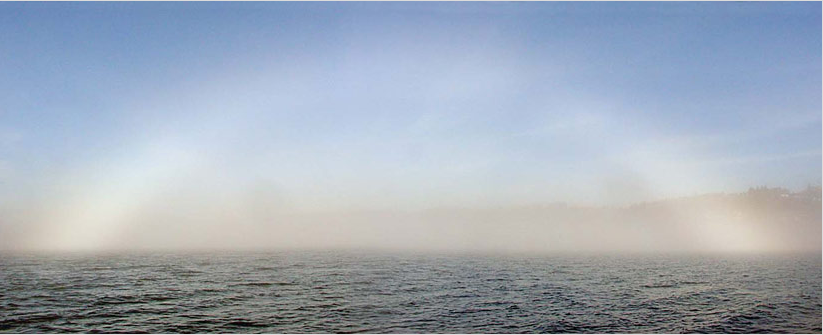Fogbow at sea
Fogbow at Sea: A Captivating Atmospheric Phenomenon
Have you ever witnessed a captivating sight while near the sea or a river on a foggy day? One such enchanting natural phenomenon is the fogbow at sea. This optical spectacle occurs when sea or river fog forms and interacts with sunlight, creating a beautiful bow-like structure in the sky. In this article, we will delve into the intricacies of fogbows at sea, exploring their formation, characteristics, and where to spot them.
Fogbows are similar to rainbows, but they have their own unique features. While rainbows are formed by the refraction, reflection, and dispersion of sunlight through raindrops, fogbows are created when sunlight interacts with tiny water droplets suspended in fog. The fog must be sufficiently thin for sunlight to penetrate through it and form the bow.
When observing a fogbow at sea, you will notice that it appears brightest at the two points where it seems closest to the water's surface. This brightness occurs because the light path through the fog is longest at those points. If you are searching for fogbows, whether on land or at sea, it is best to first direct your gaze near the horizon. Look for one or two bright patches on either side of a line facing away from the sun.
To better understand the formation of fogbows at sea, let's explore the process step by step:
-
Formation of Sea or River Fog: Fog commonly arises when warm, moist air moves over a cooler surface, such as the sea or a river. As the warm air comes into contact with the cooler water, it cools down rapidly, causing water vapor to condense and form tiny water droplets. These droplets combine to create a layer of fog.
-
Sunlight Penetration: For a fogbow to appear, the fog layer must be thin enough for sunlight to pass through. If the fog is too dense, the sunlight will be scattered and absorbed, hindering the formation of a fogbow. However, when the fog is sufficiently thin, sunlight can penetrate through the droplets, initiating the creation of a fogbow.
-
Refraction and Scattering: As sunlight enters the fog, it undergoes refraction, bending or changing direction as it passes from air to water droplets. This bending of light is responsible for the formation of the fogbow's arc shape. Additionally, some of the light is scattered by the tiny water droplets, contributing to the overall brightness of the fogbow.
-
Interference and Diffraction: Interference and diffraction phenomena also play a role in shaping the fogbow. These optical effects cause the different colors within the sunlight spectrum to spread out and overlap, resulting in the characteristic pale, pastel hues often observed in fogbows.
While fogbows at sea share similarities with their land-based counterparts, there are some distinct differences. When viewing a fogbow over the ocean or a river, the presence of water below and around the fog adds an extra dimension to the spectacle. The proximity of the water enhances the visual impact, creating a stunning interplay between the ethereal bow and the vast expanse of the sea or river.
If you find yourself fortunate enough to witness a fogbow at sea, take a moment to appreciate its ephemeral beauty. These atmospheric phenomena serve as a reminder of nature's artistic prowess and our planet's ability to create breathtaking displays in unexpected moments. So, keep your eyes peeled when near bodies of water on foggy days, and you might just be treated to a mesmerizing fogbow dancing in the sky.

Sea or river fog is an excellent source of fogbows. The fog forms when air in contact with the cooler water is chilled. To see a fogbow the fog layer must be sufficiently thin that the sun shines through. George Howard (Gallery) captured this fogbow panorama from the sloop "Pandamonium"on the Columbia River, Washington State, USA. ©2004 George Howard
This bow is brightest at the two points where it looks closest to the sea. There the light path through the fog is longest. When searching for fogbows on land or at sea look first near to the horizon for one or two bright patches each side of a line facing away from the sun.
Note: this article has been automatically converted from the old site and may not appear as intended. You can find the original article here.
Reference Atmospheric Optics
If you use any of the definitions, information, or data presented on Atmospheric Optics, please copy the link or reference below to properly credit us as the reference source. Thank you!
-
<a href="https://atoptics.co.uk/blog/fogbow-at-sea/">Fogbow at sea</a>
-
"Fogbow at sea". Atmospheric Optics. Accessed on December 27, 2024. https://atoptics.co.uk/blog/fogbow-at-sea/.
-
"Fogbow at sea". Atmospheric Optics, https://atoptics.co.uk/blog/fogbow-at-sea/. Accessed 27 December, 2024
-
Fogbow at sea. Atmospheric Optics. Retrieved from https://atoptics.co.uk/blog/fogbow-at-sea/.